Transit FireNet Workflow for GCP
You use Aviatrix Transit FireNet to deploy firewall functions for the Aviatrix Multi-Cloud transit architecture. With the Transit FireNet feature, the Firewall Network (FireNet) function is integrated into the Aviatrix Transit gateway.
To deploy firewall networks in other CSPs:
In this example, a Transit VPC with Aviatrix Gateways is deployed, and two Spoke Gateways (DEV and PROD) are attached.
A firewall of supported vendors (Check Point, Palo Alto Networks and Fortinet FortiGate, etc.) will be deployed within the Transit VPC. See the diagram below for more details.
Once the infrastructure is in place you create a policy to inspect the east-west and north-south traffic.
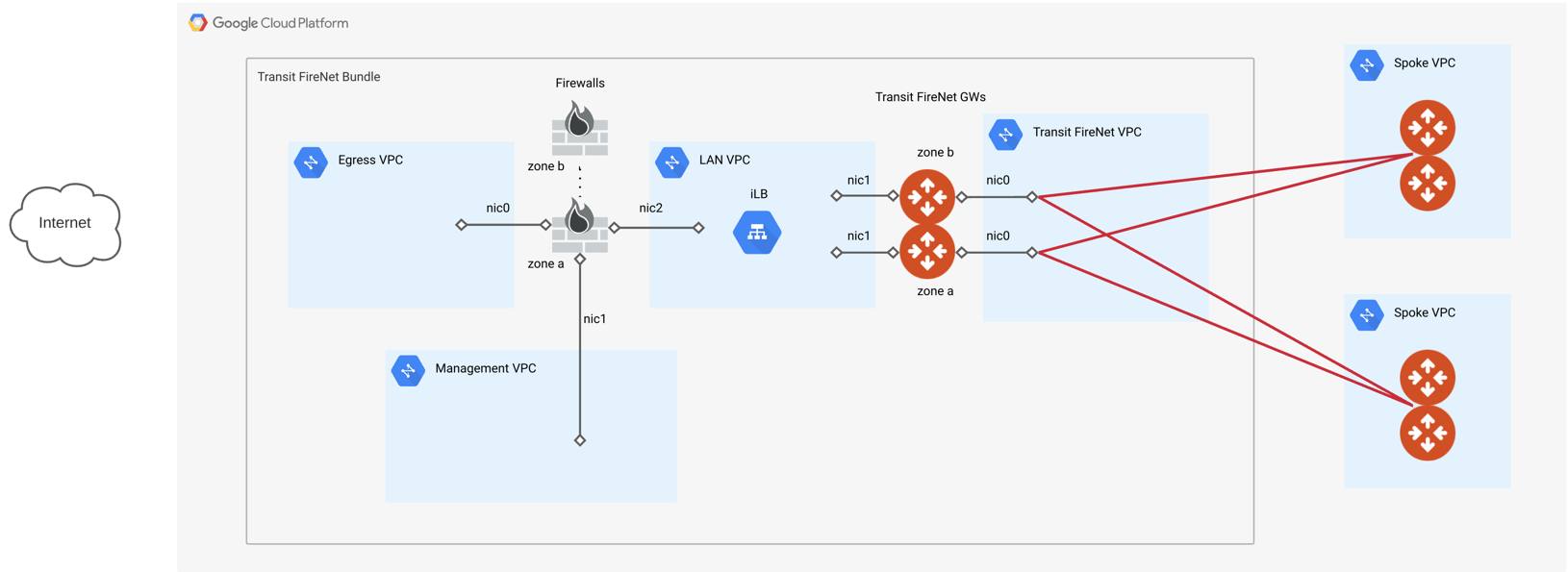
Create VPCs
VPCs can be created manually on GCP or directly from the Aviatrix Controller.
-
Log in to the Aviatrix Controller.
-
Navigate to Useful Tools > Create A VPC.
-
Select GCloud as the Cloud Type.
-
Add one VPC for the Transit FireNet Gateway and enable the Transit FireNet function as shown below.
-
Add three more VPCs as shown in the topology (i.e Egress VPC, LAN VPC and Management VPC).
-
Create two more VPCs for Spoke Gateways.
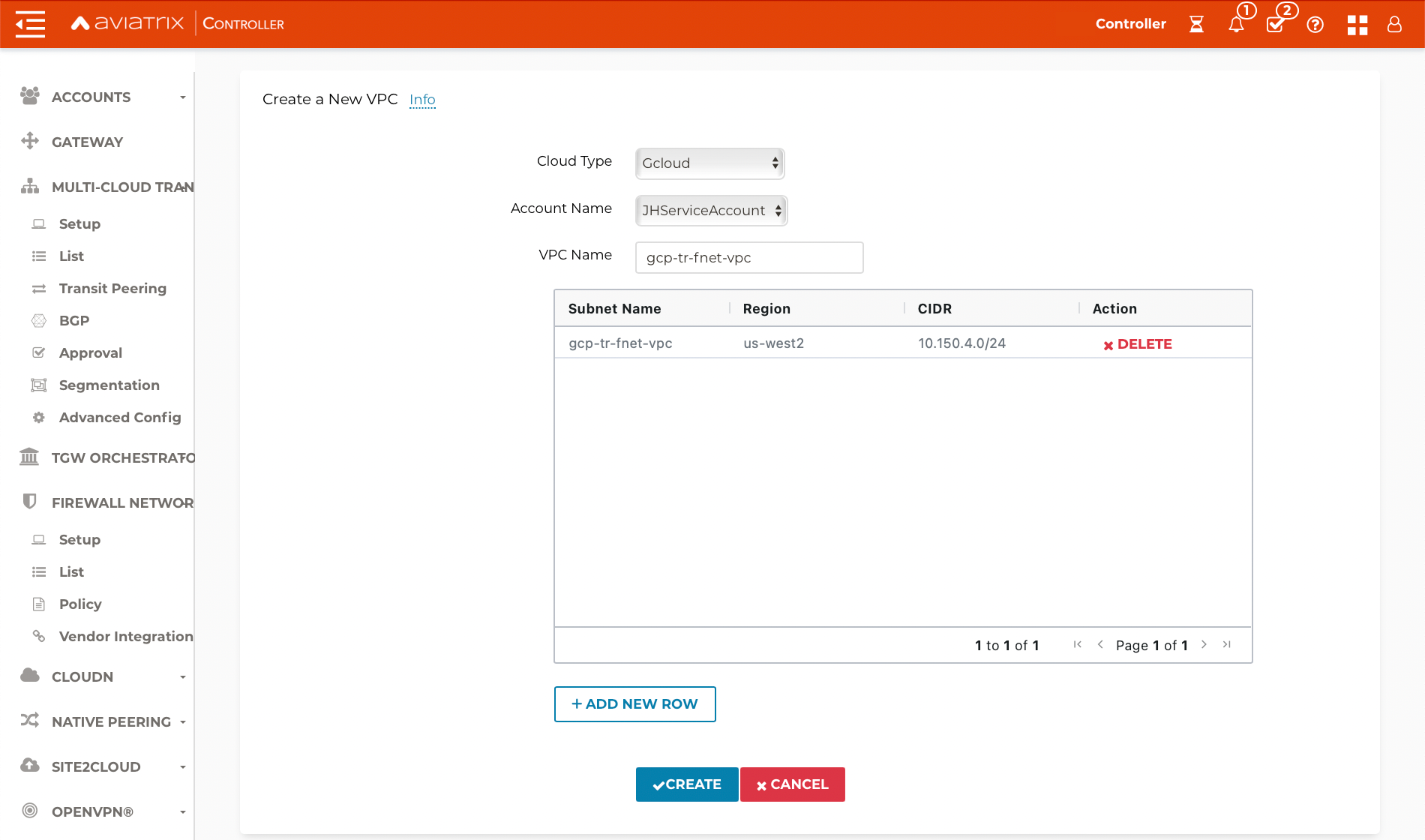
Deploy the Transit Aviatrix Gateway
The Transit Aviatrix Gateway can be deployed using the Transit Gateway Workflow.
Procedure
-
Navigate to Multi-Cloud Transit > Setup > #1 Launch an Aviatrix Transit Gateway.
-
Select the Cloud Type Gcloud.
-
Enter a Gateway Name.
-
Select the VPC ID of the Transit FireNet VPC.
-
Select the Public Subnet.
-
Select the zone.
-
Select the gateway instance size n1-standard-1.
-
(optional) Enable High Performance Mode Encryption for higher throughputs.
-
Check the Enable Transit FireNet Function checkbox.
-
Enable Transit Gateway HA by navigating to Multi-Cloud > Setup > #2 (Optional) Enable HA to an Aviatrix Transit Gateway.
ActiveMesh is always enabled.
The example below shows the configuration of the Transit FireNet gateway.
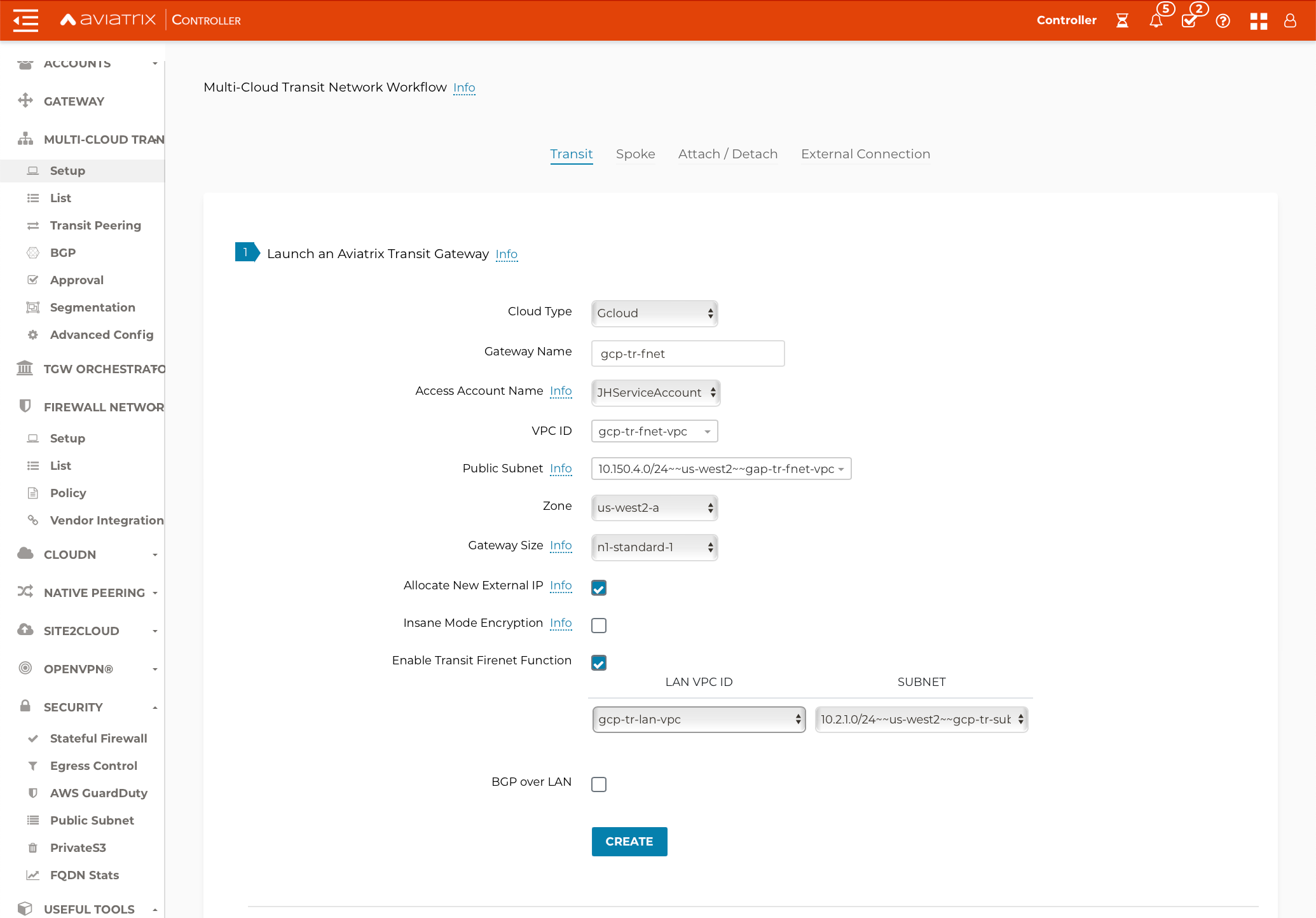
Deploy Spoke Gateways
Now that an Aviatrix Transit Gateway has been set up, Aviatrix Spoke Gateways can be deployed in the spoke VPCs using the Aviatrix Spoke Gateway Workflow.
-
Navigate to Multi-Cloud Transit > Setup > #1 Launch an Aviatrix Spoke Gateway.
-
Deploy a Spoke Gateway (GW) in each of the Spoke VPCs using the appropriate account and VPC information.
-
Choose the Public Subnet.
-
Enable Spoke Gateway HA by navigating to Multi-Cloud Transit > Setup → #5 (Optional) Enable/Disable HA at Spoke GW.

Attach Spoke Gateways to Transit Network
The Transit and Spoke gateways are now deployed. To connect them:
-
Navigate to Multi-Cloud Transit > Setup > Attach/Detach > #1 Attach Spoke Gateway to Transit Network.
-
Select one Spoke at a time and attach to the Transit Gateway.

|
Although the Transit Gateway is now attached to the Spoke Gateways, it will not route traffic between Spoke Gateways. |
Enable Connected Transit
By default, spoke VPCs are in isolated mode where the Transit will not route traffic between them. To allow the Spoke VPCs to communicate with each other, you must enable Connected Transit by navigating to Multi-Cloud Transit > Advanced Config. Select the Transit Gateway and toggle Connected Transit to Enabled.
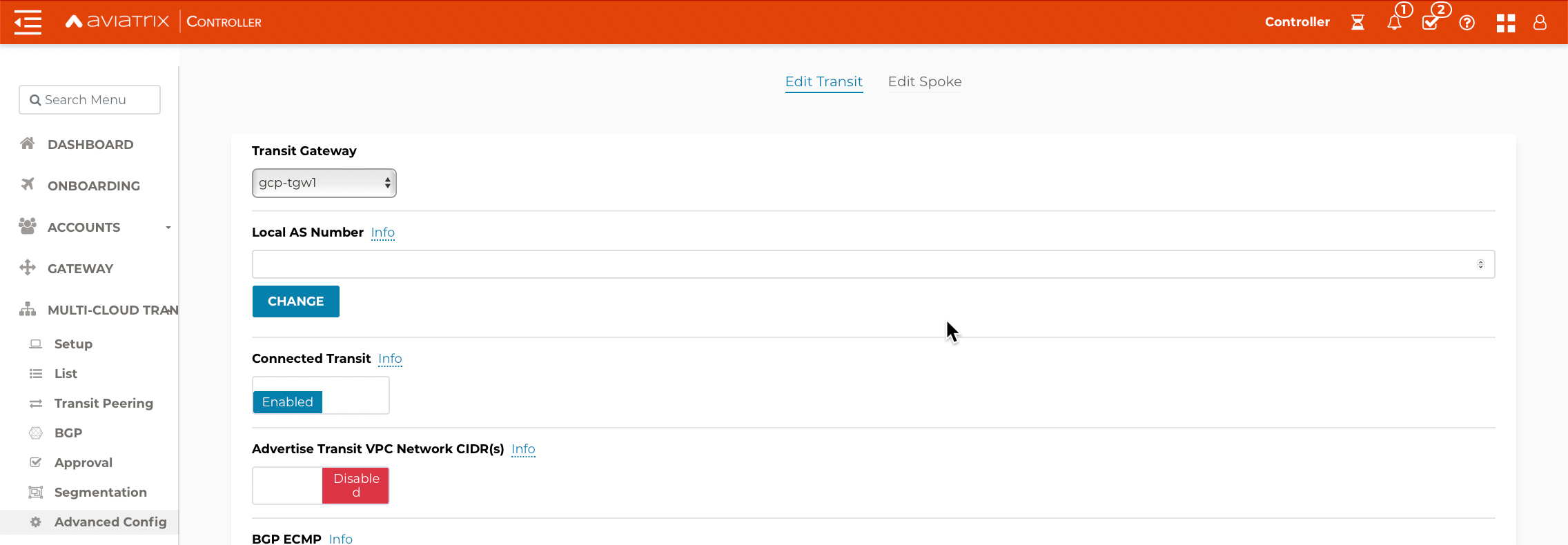
Load balancers are created in GCP after this step is performed.
Configure Transit Firewall Network
Transit and Spoke Gateways have now been deployed. You must now deploy and enable the Firewall for traffic inspection.
To enable the firewall function and configure the FireNet policy:
-
Navigate to Multi-Cloud Transit > Transit FireNet > Setup > #3a Enable Transit FireNet on Aviatrix Transit Gateway.
-
Choose the Aviatrix Transit Gateway and Click Enable.
|
In a GCP deployment, Transit FireNet function is enabled when launching the gateway. You can skip this step. |
-
Navigate to Firewall Network > Policy > Manage FireNet Policy.
-
Add Spokes to the Inspected box for traffic inspection.
|
By default, FireNet inspects ingress (INET to VPC) and east-west traffic (VPC to VPC) only. |
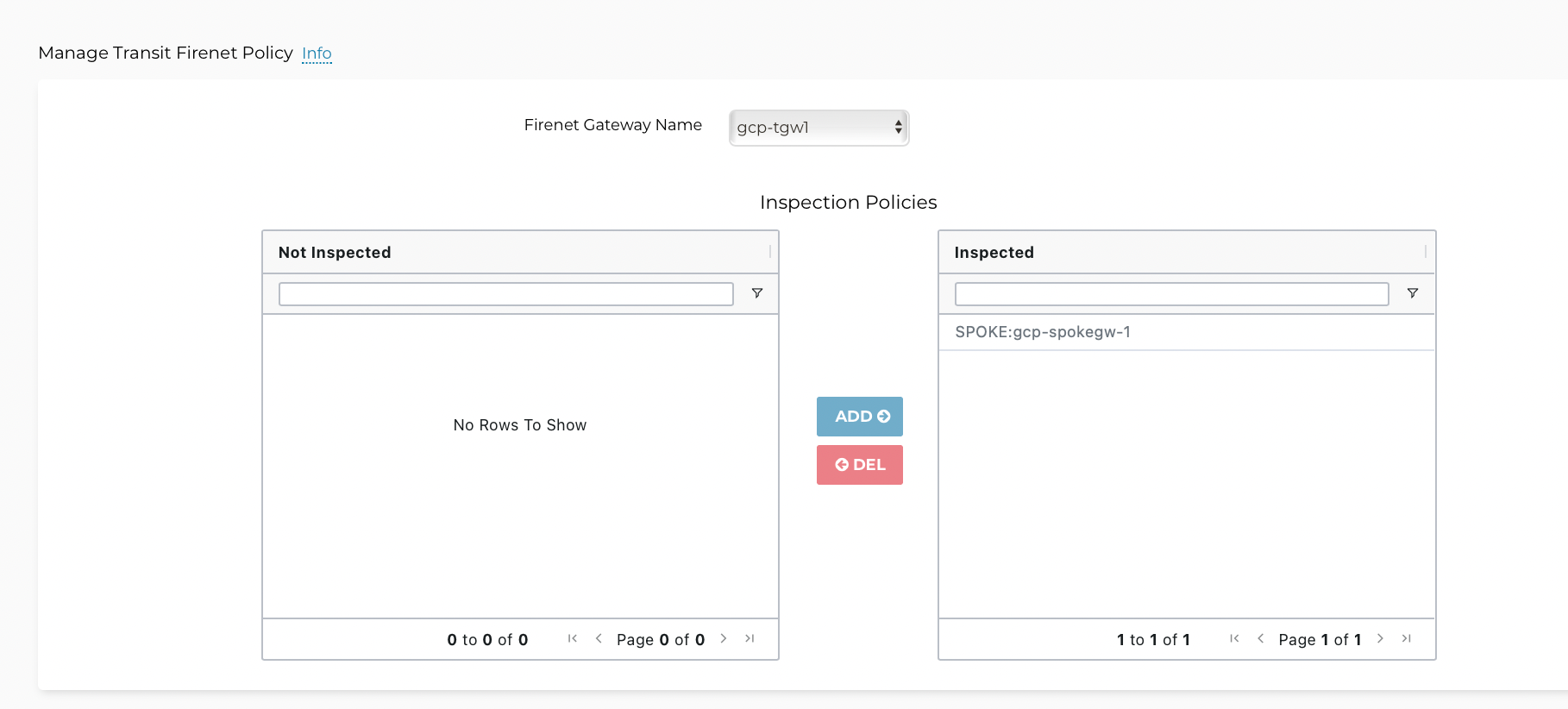
Launch and Associate Firewall Instance
This approach is recommended if this is the first Firewall instance being attached to the gateway.
This step launches a Firewall instance and associates it with one of the FireNet gateways.
|
The Firewall instance and the associated Aviatrix FireNet gateway above must be in the same AZ (Availability Zone). Also, the Management Interface Subnet and Egress (untrust dataplane) Interface Subnet should not be in the same subnet. |
Launch and Attach
In the Aviatrix Controller, navigate to Firewall Network > Setup → Firewall > Step 2a. Provide all the required input as shown in the below table. Click "Launch".
|
The vendor firewall may take 5-10 minutes to become available. |
| Setting | Value |
|---|---|
VPC ID |
The Security VPC created in Step 1. |
Gateway Name |
The primary FireNet gateway. |
Firewall Instance Name |
The name that will be displayed on GCP Console. |
Firewall Image |
The AWS AMI that you subscribed to in Step 2. |
Firewall Image Version |
Firewall instance current supported software versions. |
Firewall Instance Size |
Firewall instance type. |
Management Interface VPC ID |
Select the Firewall Management VPC |
Management Interface Subnet |
Select the subnet for Firewall Management |
Egress Interface VPC ID |
Select the Firewall Egress VPC. |
Egress Interface Subnet |
Select the subnet for Firewall Egress. |
Attach (Optional) |
By selecting this option, the firewall instance is inserted in the data path to receive the packet. If this is the second firewall instance for the same gateway and you have an operational FireNet deployment, you should not select this option as the firewall is not configured yet. You can attach the firewall instance later at the Firewall Network → Advanced page. |
Advanced (Optional) |
Click this selection to allow Palo Alto firewall bootstrap files to be specified. |
Bootstrap Bucket Name |
In advanced mode, specify a bootstrap bucket name where the initial configuration and policy file is stored. |
Check Point Specifications
Check Point support for Google Cloud will be available in a future release.
Palo Alto VM-Series Specifications
Palo instance has three interfaces as described below.
| Palo Alto VM instance interfaces | Description | Inbound Security Group Rule |
|---|---|---|
nic0 |
Egress or Untrusted interface |
Allow ALL |
nic1 |
Management interface |
Allow SSH, HTTPS, ICMP, TCP 3978 |
nic2 |
LAN or Trusted interface |
Allow ALL (Do not change) |
Note that firewall instance nic2 is on the same subnet as the FireNet gateway nic1 interface.
|
For Panorama managed firewalls, you need to prepare Panorama first and then launch a firewall. See Managing VM-Series by Panorama. When a VM-Series instance is launched and connected with Panorama, you need to apply a one time "commit and push" from the Panorama console to sync Panorama and the firewall instance. |
|
If VM-Series are individually managed and integrated with the Controller, you can still use Bootstrap to save initial configuration time. Export the first firewall’s configuration to bootstrap.xml, create an IAM role and Bootstrap bucket structure as indicated above, then launch additional firewalls with IAM role and the S3 bucket name. |
Follow Palo Alto Network (VM Series) GCP Example to launch VM Series firewall in GCP and for more details.
FortiGate Specifications
Click here for more information on how to launch the FortiGate firewall in GCP.
Associate an Existing Firewall Instance
This is the alternative step to Step 2a. If you already launched the firewall (Check Point, Palo Alto Network or Fortinet) instance from the AWS Console, you can still associate it with the FireNet gateway.
In the Aviatrix Controller navigate to Firewall Network > Setup > Step 2b and associate a firewall with a FireNet Gateway.
Vendor Firewall Integration
Vendor integration programs RFC 1918 and non-RFC 1918 routes in the firewall.
-
In the Aviatrix Controller, navigate to Firewall Network > Vendor Integration > Firewall.
-
Select the firewall Vendor Type and fill in the details of your firewall instance.
-
Click Save.
-
You can click Show or Sync to show the integration details or sync the configuration with the firewall.
Example Setup for "Allow All" Policy
After a firewall instance is launched, wait 5-15 minutes for it to become available. Time varies for each firewall vendor. In addition, please follow the example configuration guides as indicated below to build a simple policy on the firewall instance, to validate that traffic is indeed being routed to firewall instance.
Palo Alto Network (PAN)
For basic configuration, please see the example Palo Alto Network configuration guide.
Verification
There are multiple ways to verify if Transit FireNet is configured properly:
-
Aviatrix Flightpath - Control-plane Test
-
SSH, SCP or Telnet Test between Spoke VPCs (East-West) - Data-plane Test
|
ICMP is blocked on Google Cloud Load balancer |
Flight Path Test for FireNet Control-Plane Verification:
Flight Path is a powerful troubleshooting Aviatrix tool which allows users to validate the control plane and gives end to end visibility of packet flow.
-
Navigate to Troubleshoot> Flight Path.
-
Provide the Source and Destination Region and VPC information.
-
Select SSH and Private subnet, and run the test.
|
A VM instance will be required in GCP, and SSH/Telnet port should be allowed in firewall rules for Spoke VPCs. |
SSH/Telnet Test for FireNet Data-Plane Verification:
Once the control plane is established and no problem are found in the security and routing polices, you need to verify that traffic is flowing and not blocked.
There are multiple ways to check the data-plane. One way is to SSH into Spoke instance (e.g. DEV1-VM) and telnet the other Spoke instance (e.g PROD1-VM) to make sure there is no traffic loss in the path.